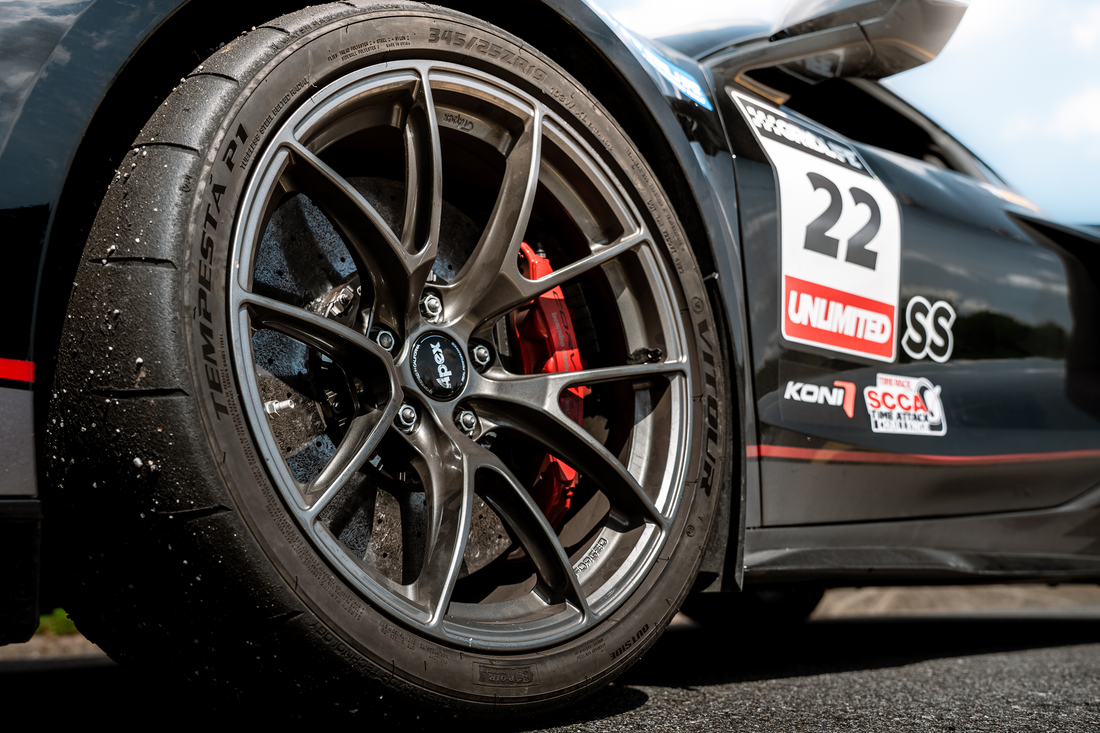As the 2025 season winds down, we’re taking a look at what testing and driver feedback have shown about sizing the Vitour P1 and how it performs across different platforms. Tire size isn’t just a number on the sidewall—it influences grip, gearing, clearance, and how your car handles under pressure. The P1 has proven itself everywhere from Miatas on 15x8s to widebody Corvettes running square 345s. Whether you’re debating a 305 on a 10-inch wheel or testing if a 345 fits up front, here’s what the community and real-world data show works best.
The P1 Runs True—But Tread Width Is Forgiving
P1s typically measure close to listed specs, with actual width depending on the size, but comparable tires like the RE71RS or A052. The sidewall is square and flatter, meaning a more flush-mounted look—especially on matched or wider wheels.
“The P1 looks a little more square than the RE71RS at the same size. Flush to the wheel instead of bulging.”
Sizing Strategy: Go Big—Even on a Pinch
Unlike other 200tw tires, the P1 is unusually tolerant of tight wheel fitment. A slightly stretched setup is still ideal, but mounting the widest tire that physically fits—even if it’s pinched—is often faster.
“If it fits, it works.”
On the C8 platform, for example, the 345/25R19 mounted on a 19x11 front (and 19x13.25 rear) tested faster than both 305s and 285s. Similarly, on a Lotus platform, a 285 P1 on a 15x11 outperformed multiple narrower setups on 9" wheels.
Don’t hesitate to run a 345 on an 11", or a 295 on a 10", especially if your goal is overall grip rather than sidewall aesthetics.
Fitment by Use Case
Autocross
Class rules often limit wheel width, but the P1 performs well even with some pinch:
- 245s on 9.5"
-
255s on 10"
-
295s on 10"–11"
-
345s on 11" are proven to work
Track
Wider is better if you have the clearance. A 345 on a 13" wheel will offer more performance and stability than a 315 on the same width.
- 315/30 on 11.5" is common
- 345/30/18 excels on 12–13" setups
- On a C8, square 345/25R19 setups are working well front and rear
Street
Stretch is fine, and the curb guard helps protect rims—but be aware of deflection under load and keep an eye on ride height when running shorter sidewall specs.
Sidewall and Ride Height Considerations
Vitour P1s are available in both 25 and 30-series sidewalls, which can create significant ride height differences—especially in platforms like the Miata or C8.
“The 225/40-15 is only 22” tall. I couldn’t even get a jack under the car.”
A change from 35 to 40 series on a 15" wheel can help recover needed clearance or correct speedometer error.
Platform-Specific Notes
Corvettes
Popular setups include 285/30/20 front and 345/25/21 rear, which align closely with OEM specs. For more grip, some drivers are running 305/30/20 fronts—even on 10" wheels—with only light rub at full crank in reverse.
If you're looking to go square, setups like 345/25R19 on 19x11 (front) and 19x13.25 (rear) have tested fast and balanced on autocross and road course applications.
On 18" wheels, a 295/30R18 front and 345/30R18 rear is also a proven setup—especially for widebody trims with enough fender clearance.
The 345/25/21 is available now and has quickly become a go-to rear option for high-performance builds.
GT4
305/30/20 P1s compare favorably to Nankang CR-S in speed and heat tolerance. Fitment can be tight on stock wheels, but with proper camber and ride height, they clear.
Miata (15” platform)
305/30/15 is a standout for ST-level classes. For narrower wheels, a 225/45R15 on a 15x7 will physically fit, but 15x8+ is better. The 205/50R15 is optimal on a 7" wheel.
“225s will fit on 7s, but wear, response, and grip will suffer. 205s work better.”
Final Thoughts
The P1 doesn’t run oversized or undersized—it runs smart. What matters is how it’s supported and used. With its ability to perform even on pinched wheels and its high grip window when heat and pressure are dialed in, the P1 rewards those who experiment and tune their full setup.
Need more tuning advice? Check out our Camber Blog and Tire Pressure Blog.

